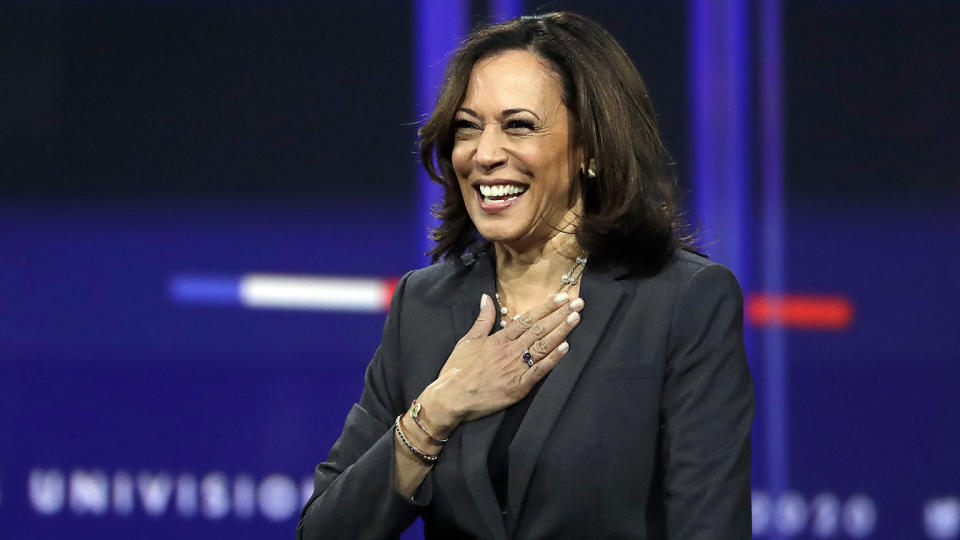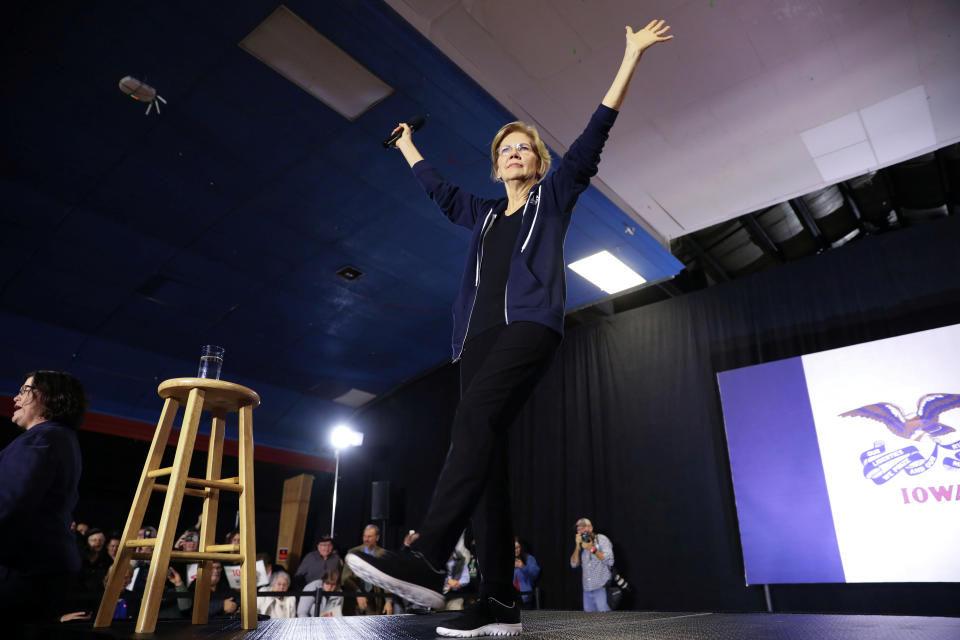Kamala Harris goes on the veep shortlist — even Biden's
Welcome to 2020 Vision, the Yahoo News column covering the presidential race with one key takeaway every weekday and a wrap-up each weekend. Reminder: There are 60 days until the Iowa caucuses and 334 days until the 2020 election.
Most pundits made two observations immediately after Kamala Harris dropped out of the Democratic primary this week.
One, since she was the only candidate of color to crack the top tier in 2019 or to qualify for the upcoming December debate, Harris’s departure would transform the visible ranks of what had once been the most diverse presidential primary field into an all-white affair.
And two, she could be a really good running mate for whoever winds up winning the nomination.

“Of course I would,” Joe Biden said Wednesday in Iowa when asked whether he’d consider asking Harris to join his ticket. “Sen. Harris has the capacity to be anything she wants to be. I talked to her yesterday. She’s solid. She can be the president one day herself. She can be the vice president.”
Biden’s enthusiasm for Harris was undampened by the memory of their clash at the first Democratic debate, when she briefly vaulted into the top tier of candidates with a spirited attack on ... Joe Biden. That’s because the Biden campaign knows all too well that the 2020 Democratic primary is the first to unfold in the wake of both the Black Lives Matter and #MeToo movements. Democratic primary voters are more “woke” than ever; they know that women and minority voters, and black women in particular, form the foundation of their coalition. Yet they have watched with growing frustration as every plausible woman or minority candidate except Elizabeth Warren — i.e., Harris, Cory Booker, Julián Castro, Kirsten Gillibrand — has been sidelined or forced from the race.
And this is the primary reason that politicos are suddenly saying that Harris, whose parents were Jamaican and Indian immigrants, would be such a compelling VP pick. She is something that none of the likely nominees now are: a woman of color. If you can’t have representation at the top of the ticket, the thinking goes, you’d better have it in the No. 2 slot.
The result? The winnowing and whitening of the presidential field has winnowed, unwhitened and generally diversified the vice presidential field.

Only two previous vice presidential nominees have been women: Democrat Geraldine Ferraro in 1984 and Republican Sarah Palin in 2008. Not a single one has been a person of color. But with political pressure rising on the left, it is becoming more and more difficult to imagine one of the four frontrunners — Biden, Warren, Bernie Sanders or Pete Buttigieg — raising arms with a straight white male VP pick at next summer’s Democratic National Convention in Milwaukee.
As the running mate of Barack Obama and the preferred candidate of black Democrats — he typically polls better with black voters than the rest of the field combined — Biden might have more running-mate wiggle room than his rivals. But not much. In fact, his biggest liability as the nominee would be a lack of enthusiasm among women and younger progressives, white or otherwise, who view him as an untrustworthy centrist and cultural dinosaur with a tendency toward overfamiliarity with members of the opposite sex and a history of putting his foot in his mouth whenever he talks about race. Such progressives will expect Biden to address their concerns by choosing a woman and/or a person of color as his veep — which is why he also reportedly floated the idea of a joint ticket with Stacey Abrams at the very start of his campaign. Asked shortly before Thanksgiving who was on his VP shortlist, Biden mentioned only women: “the former assistant attorney general who got fired" (Sally Yates), “the woman who should have been the governor of Georgia" (Abrams) and “the two senators from the state of New Hampshire” (Jeanne Shaheen and Maggie Hassan).
Warren might be the only other top-tier contender who doesn’t have to deal with the same concerns, being a woman herself. As a trailblazer, she could choose a white man to allay doubts about her electability, the way Hillary Clinton tapped the uncontroversial former Virginia Gov. Tim Kaine. But so far Warren hasn’t worried much about conventional notions of electability, preferring instead to wager that inspiration (i.e., motivating progressives with big, bold ideas) is a surer path to the White House than persuasion (i.e., trying to meet would-be Republicans in the middle). And so it would be less in character for her to pick someone like Ohio Sen. Sherrod Brown — a rare red-state progressive who was Clinton’s backup choice in 2016 — than someone like former Housing and Urban Development Secretary Julián Castro or former Tallahassee, Fla., Mayor Andrew Gillum, who narrowly lost his campaign for Florida governor last year. Warren is on conspicuously good terms with the former and has recently “been in contact” with the latter.

As for Sanders and Buttigieg, they would pursue the traditional white-man VP path at their peril. Buttigieg’s struggles with black voters are so well documented that he would almost certainly want to choose someone of color, and although Sanders polls better than Buttigieg among black voters (and Latinos), he has long promised a “political revolution” — not a ticket that looks pretty much like every one of his predecessors’.
“Gender and racial diversity is extremely important to me,” Buttigieg explained in October. “It will be a central consideration in selecting a running mate.”
“I think we would look for somebody who is maybe not of the same gender that I am,” Sanders said in February, while noting that his 2016 campaign was “rightly” criticized for being “too white.”
So who is likely to win next year’s Democratic veepstakes? It all depends, of course, on who secures the party’s presidential nomination. But as those choices get whiter and more male, the shortlist seems to be moving in the opposite direction. According to the betting market PredictIt, Abrams is the 6-1 favorite right now; Buttigieg, by far the most prominent gay presidential candidate in U.S. history, is behind her at 7-1. Then it’s Harris (9-1), Amy Klobuchar (10-1), Booker (12-1), Castro (13-1) and Tulsi Gabbard (16-1).
The only straight white men on the list — Brown, Beto O’Rourke and, bizarrely, Biden — are at the bottom.
It remains to be seen whether awarding the VP role to a woman, a person of color or, in Buttigieg’s case, a gay man will soothe and reanimate progressives disillusioned by the shrinking diversity of the presidential field. But it’s increasingly likely that whoever captures the party’s nomination will have to give it a try.
Download the Yahoo News app to customize your experience.
Read more from Yahoo News:





